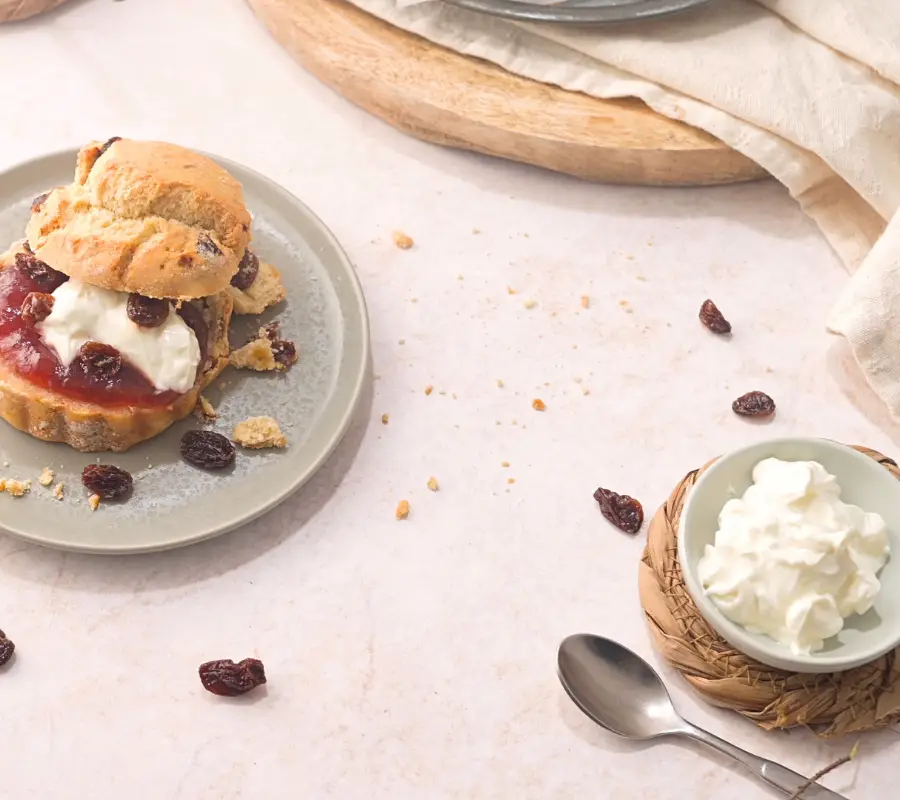Can You Freeze Clotted Cream? How To Do It Safely
Clotted cream, often associated with the delights of cream tea, is a staple of British culinary tradition known for its thick consistency and rich flavour. As a lover of this creamy delight, you may wonder if you can preserve its velvety texture for future use. The answer is affirmative; clotted cream can indeed be frozen, which is a great way to extend its shelf life and reduce food waste.
The process involves ensuring that the cream retains its quality. To achieve this, take care to store the clotted cream properly, using an airtight container or freezer bag to prevent freezer burn and the formation of ice crystals.
Whether you’ve prepared a homemade batch or have a surplus from your local grocery store, you can savour your cream well past its usual expiry date—with the right techniques, you can enjoy a dollop of this luxurious cream on a warm scone or a slice of sticky toffee pudding at your convenience.
Key Tips
- Clotted cream can be successfully frozen for later enjoyment.
- Proper storage in an airtight container or freezer bag is essential.
- Correct thawing ensures the clotted cream retains its sumptuous quality.

Preliminary Considerations Before Freezing
Before you place your clotted cream into the cold confines of the freezer, it’s essential to consider its initial state and how it might transform during the freezing process. Here are some specifics to ponder.
Assessing Quality and Freshness
When you procure a pot of fresh clotted cream, perhaps for a delightful afternoon tea, ensure it’s before its use-by date. It should possess a creamy texture and a pleasant aroma without any acidic smell. Fresh clotted cream, especially variants like Cornish cream or Devonshire cream, are known for their high fat content which aids in a longer shelf life when frozen.
- Check the expiration date
- Aroma should be fresh, not sour
- Look for any signs of texture changes at room temperature
Understanding Texture Changes
While clotted cream boasts a luxurious high-fat content that cream freezes well, you’ll need to acknowledge potential slight texture changes after thawing. For the best results, freezing in smaller amounts suitable for future use is a good strategy. Use an airtight container or freezer bag to minimise ice crystals that could affect the smooth texture.
- Texture changes can occur; aim for minimal exposure to air
- High-fat dairy products like clotted cream endure low temperature storage better
- Freezing process can be optimised with the right container
Incorporating these considerations ensures your clotted cream remains a delicious treat for your cream tea or baked goods for a long time.
Freezing Clotted Cream
Properly freezing clotted cream can maintain its velvety texture and rich flavour, making it available long past its usual shelf life. Here’s how you can store this dairy indulgence for that spontaneous cream tea or special occasion.
How to freeze clotted cream
Step-by-Step Freezing Process
Begin by placing the clotted cream in an airtight container, ensuring that only small amounts are stored to avoid waste. Fill the container, but leave a bit of space at the top; as cream freezes, it expands.
If you’re using freezer bags, squeeze out any excess air before sealing to minimise the formation of ice crystals that can affect texture. Label each bag or container with the content and the freezing date for easy identification.
Selecting Appropriate Containers
For best results, select containers that are made for freezer use. Glass jars can be an excellent choice, provided they are freezer-safe to prevent any cracking at low temperatures.
Plastic containers or resealable bags are also suitable choices; just ensure they are sturdy and designed to withstand freezing without becoming brittle. Wrap these with an additional layer of cling film or plastic wrap as an extra barrier against freezer burn.
Food Safety Precautions
When freezing any dairy products, it’s important to maintain food safety standards. Clotted cream should be stored at a safe low temperature as soon as possible after purchase or preparation to prevent bacterial growth.
When ready to use, thaw it in your fridge rather than at room temperature to ensure it remains at a safe temperature throughout the thawing process. It’s not recommended to refreeze thawed clotted cream, as this can compromise both its safety and quality.

Post-Freezing Handling
After freezing your clotted cream, proper handling is crucial to maintain its quality. Specific steps should be taken when thawing and considering refreezing to ensure the creamy texture that clotted cream is known for.
Thawing Instructions
To thaw frozen clotted cream safely, transfer it from the freezer to the fridge, and allow it to defrost slowly. Ideally, place the airtight container containing the clotted cream into the fridge the night before your afternoon tea, to ensure a slow and gentle thaw.
This approach minimises the risk of texture changes such as becoming grainy or gritty. Avoid thawing at room temperature as it can lead to oxidation, which might spoil the cream’s delicate flavour.
Refreezing Risks
Refreezing clotted cream is not recommended because it can degrade the texture further and result in a product that’s less enjoyable to consume.
Every freeze-thaw cycle introduces the risk of ice crystals forming, which breaks down the rich and velvety texture of the clotted cream. If you anticipate needing only small amounts, consider freezing the cream in smaller portions for future use. This practice helps in reducing food waste while still preserving the delicious treat for that special occasion.
Optimising Clotted Cream Use After Freezing
After successfully freezing clotted cream, there are strategic ways to use it in various recipes to ensure that its creamy texture and rich flavour are maximised. Thawing the cream properly and incorporating it into the right dishes can make a significant difference in taste and texture.
Creative Culinary Applications
Frozen clotted cream is versatile and can be used in numerous desserts and baked goods. Its high fat content means it retains a thick creaminess even after freezing, making it ideal for use in recipes where a rich texture is desired.
For instance, frozen clotted cream is a perfect addition to ice creams, lending them a luxurious creaminess. When making a fruit crumble, you can dot small amounts of clotted cream on top before baking to create a velvety texture within the dessert.
Another fantastic idea is creating sauces or soups that require a touch of luxury. Gently warming the clotted cream at low temperatures and incorporating it into your soup can enhance the creaminess without overpowering the dish.
Additionally, if you enjoy a hearty breakfast biscuit or warm scones, spreading thawed clotted cream, possibly mixed with strawberry jam, can make for a delightful afternoon tea treat.
Ensuring Maximum Enjoyment
To achieve the best results, ensure that your frozen clotted cream is thawed correctly. Transfer the cream from the freezer bag to an airtight container before leaving it in the fridge. Allow the cream to reach room temperature slowly to minimise the formation of ice crystals and reduce the chances of freezer burn. Maintaining a smooth texture is crucial, as ice crystals can affect the texture of the cream.
When ready to use, be mindful of any slight texture changes. If the clotted cream seems less thick than usual, it can still be excellent for recipes where it is melded into the product, such as in pancakes or waffles. Remember, it might not be the first time you experience changes, so personal preference will guide how to best use the thawed clotted cream for future use.
Remember, freezing and thawing clotted cream may not replicate the freshly baked scone experience that is cherished in the United Kingdom, but it’s a great way to avoid food waste and have this delicious treat ready for a special occasion or when the craving hits.
Using frozen clotted cream can prolong its longer shelf life and ensure that your cherished dairy products are available whenever required, with that familiar creamy taste and rich flavour.
Storing Frozen Clotted Cream
When freezing clotted cream, it’s essential to store it correctly to prevent freezer burn and maintain its creamy texture. Here’s the best way to do it.
Labeling and Organisation
Before placing your clotted cream in the freezer, ensure it’s in an airtight container or a freezer bag to protect it from air exposure. Label each container with the date of freezing with a waterproof marker to keep track of how long the cream has been stored. Organising your frozen dairy products by date will minimise food waste and help maintain the best quality.
Maximising Shelf Life
To maximise the shelf life of your frozen cream, keep it at a low temperature in the deepest part of the freezer. This helps to preserve the high-fat content and velvety texture, preventing the formation of ice crystals that can alter the consistency.
Portioning the clotted cream in small amounts suitable for future use can make it easier to thaw without needing to defrost the entire batch. It’s also a good idea to retain the original packaging if it is suitable for freezing and provides a thick layer of protection.
Frequently Asked Questions
When considering freezing clotted cream, several questions might arise in your mind. The right knowledge can ensure that your clotted cream retains a creamy texture and rich flavour, even after being stored in the freezer.
For what duration can clotted cream be stored in the freezer?
Clotted cream can be kept in the freezer for up to three months. To maintain the velvety texture and prevent freezer burn, it’s important to store the cream in an airtight container or heavy-duty freezer bag.
Is it possible to freeze clotted cream that has been produced at home?
Yes, you can freeze homemade clotted cream. Ensure that it’s cooled to room temperature before placing it in a freezer-safe container. This is a great way to keep your delicious treat for future use.
What is the recommended method for thawing frozen clotted cream swiftly?
To thaw clotted cream quickly, transfer it from the freezer to the fridge a few hours before it’s needed or submerge the airtight container in a cold water bath for faster results. Do not thaw at room temperature as it could affect the creamy texture.
Is it safe to freeze clotted cream on multiple occasions?
It is not recommended to refreeze clotted cream. Each freezing process can alter the creamy texture, leading to ice crystals and a grainy final product. It’s best to freeze in smaller portions for single use.
After being defrosted, how long does clotted cream remain consumable?
Once defrosted, clotted cream should be consumed within a few days for best results. Storing the thawed cream in the fridge and keeping it covered will help maintain its freshness.
What are the indicators that clotted cream has gone off?
Off clotted cream may exhibit sour smell, discolouration, or mould growth. The texture of the cream might become watery or clumpy. If you notice any of these signs, it’s best to discard the cream to avoid food waste.